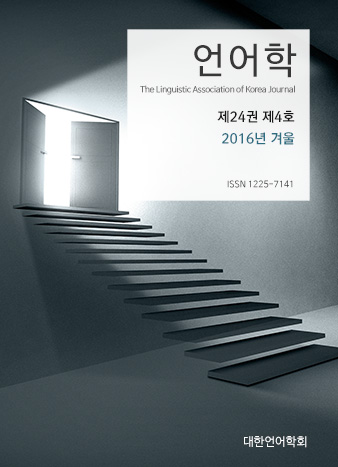대한언어학회 전자저널

-
An Alternative Approach to Realizations of the Medial [nt] Cluster in English
-
Boundary and pitch effects on the perception of Korean alveolar nasal
-
Corpus-Based English Grammar Instruction in a Korean College Context Korean College Context
-
A Study on the Relationship between Self-Efficacy Beliefs and Comprehension in English Reading
24권 4호 (2016년 12월)
- Boundary and pitch effects on the perception of Korean alveolar nasal
-
Hyunsook Kang
Pages : 23-38
Abstract
Keywords
# alveola nasal perception # different prosodic categories # progressive place assimilation
References
- Bybee, J. (2000). Lexicalization of sound change and alternating environments. In M. Broe & J. Pierrehumbert (Eds.), Papers in laboratory phonology (pp. 250-268). Cambridge: Cambridge University Press.
- Cho, T. (2016). Prosodic boundary strengthening in the phonetics-prosody interface. Language and Linguistics Compass, 10(3), 120-141.
- Hillenbrand, J. (1984). Speech perception by infants: Categorization based on nasal consonant place of articulation. Journal of the Acoustical Society of America, 75, 1613-1622.
- Kang, H. (2015). An argument for cue-based theory in Korean: Progressive assimilation and deletion. Paper presented at 2015 ICKL & Harvard-ISOKL, Chicago, Illinois, 24-27, July.
- Kang, H. (2016). Perceptual deletion of onset /n/ in Korean. The Linguistic Association of Korea Journal, 24(3), 1-16.
- Krivokapić, J. & Byrd, D. (2012). Prosodic boundary strength: An articulatory and perceptual study. Journal of Phonetics, 40(3), 430-442.
- Kurowski, K. & Blumstein, S. (1984). Perceptual integration of the murmur and formant transitions for place of articulation in nasal consonants. Journal of the Acoustical Society of America, 76, 383-390.
- Ladefoged, P. & Johnson, K. (2015). A course in phonetics. Stanford: Cengage Learning.
- Liberman, A., Delattre, P., Cooper, F., & Gerstman, L. (1954). The role of consonant-vowel transitions in the perception of the stop and nasal consonants. Psychol. Mono., 68, 1-13.
- Malécot, A. (1956). Acoustic cues for nasal consonants: An experimental study involving a tape-splicing technique. Language, 32, 274-284.
- Ohala, J. (1985). Linguistic and automatic processing of speech. In R. De Mori & C. Suen (Eds.), New systems and architectures for automatic speech recognition and synthesis (pp. 447-475). Berlin: Springer-Verlag.
- Ohala, J. (1993). The phonetics of sound change. In C. Jones (Ed.), Historical linguistics: problems and perspectives (pp. 237-278). London: Longman.
- Repp. B. (1986). Perception of the [m]-[n] distinction in CV syllables. Journal of the Acoustical Society of America, 79, 1987-1999.
- Recasens, D. (1983). Place cues for nasal consonants with special reference to Catalan. Journal of the Acoustical Society of America, 73, 1346-1353.
- Steriade, D. (2001). Directional asymmetries in place assimilation: a perceptual account. In E. Hume & K. Johnson (Eds.), The role of speech perception in phonology (pp. 219-250). San Diego, CA: Academic Press.